- There are no more items in your cart
- Shipping Calculated at checkout
- Sub-Total (inc. VAT) £0.00
Need Help?
Antifouling Paints
Anti-fouling paint is a crucial tool for maintaining the performance and longevity of marine vessels. It prevents the growth of marine organisms like barnacles, algae, and weeds on the hull, which can cause drag, reduce fuel efficiency, and potentially damage the hull. This category delves into the importance of anti-fouling paint available to buy at rawlinspaints.com, its application and maintenance (in-line with the "Protect Collect & Dispose Initiative"), and detailed insights into products from renowned brands like Jotun, Teamac, PPG, and International. Click for more info.
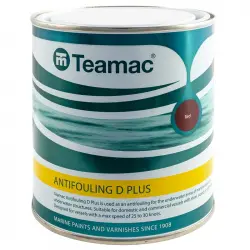
Teamac Antifouling D Plus
In Red, Black, Green, Blue, and Light Grey. Antifouling paint for protecting marine vessels from fouling organisms. For steel, wood, and GRP hulls. Not suitable for aluminium. Provides up to 24 months of protection. Professional use only.For Reference:See our guide to applying anti-fouling paints in-line with the "Protect Collect...
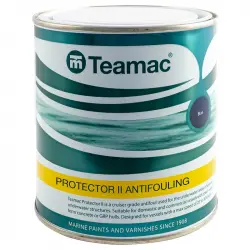
Teamac Protector II Antifouling
In black, red or blue. Designed for effective antifouling protection for vessels. For steel, wood, ferro concrete, and GRP hulls, providing long-lasting protection against marine growth. Offers 12 to 18 months of protection.For Reference:See our guide to applying anti-fouling paints in-line with the "Protect Collect & Dispose...
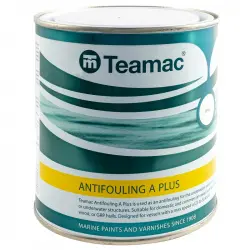
Teamac Antifouling A Plus
In White, Black, Blue, and Red. Two-pack antifouling solution designed to protect marine vessels from biofouling. For aluminium, steel, wood, and GRP hulls of marine vessels. Functional life of 18 to 24 months. Professional use only.For Reference:See our guide to applying anti-fouling paints in-line with the "Protect Collect...
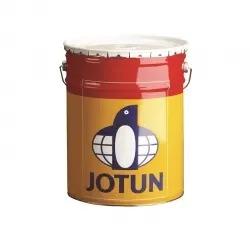
Jotun SeaForce 90
The optimal choice if you are looking for a fuel saving antifouling at a cost effective level. With a predictable and effective performance, Jotun SeaForce 90 limits the hull deterioration caused by fouling throughout the whole sailing interval. This is achieved through a controlled and predictable polishing rate, combined with an effective...
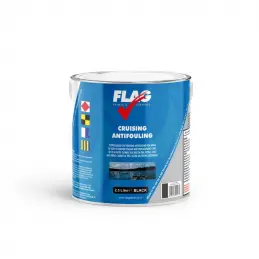
Flag Cruising Antifouling
Economical (cruising grade) copper based antifouling which is free from booster biocides. It is a self-eroding antifouling with proven performance within a wide variety of UK conditions and many European locations.For use on boat hulls for areas of low to medium fouling - suitable for general sailing and displacement craft with speeds up...
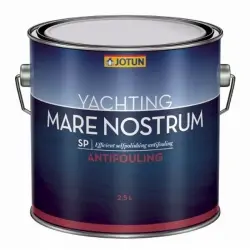
Jotun Mare Nostrum SP
Self-polishing antifouling based on a unique binder combination system.Totally active surface. Clean hull for the whole season. Continuously renews. True colour once immersed. Excellent fouling protection. For fresh water.For Reference:See our guide to applying anti-fouling paints in-line with the "Protect Collect &...
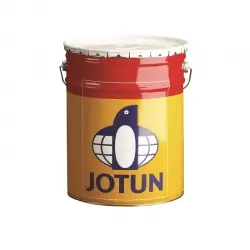
Jotun SeaForce 30 M
The optimal choice if you are looking for a very good antifouling for maintenance and repair.Predictable and effective performance. Limits hull deterioration caused by fouling throughout the whole sailing interval. This is achieved through a controlled and predictable polishing rate, combined with an effective mix of biocides....
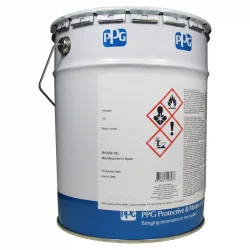
PPG Sigma EcoFleet 530
High-activity, self-polishing antifouling for extreme and aggressive fouling conditions, controlling shell and weed fouling for service periods up to 60 months, depending on vessel type, operation characteristics and system applied.One component. TBT-free self-polishing antifouling for new-building and maintenance. Controlled polishing...
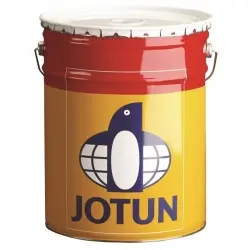
Jotun SeaQuantum Ultra S
State of the art chemically hydrolysing silyl acrylate antifouling coating. It provides excellent fouling protection and incomparable hull performance. This is achieved through highly predictable and stable self polishing characteristics reducing hull deterioration, friction and speed loss. The initial smooth surface provides a very good...
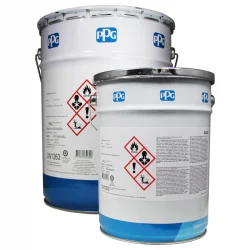
PPG SigmaGlide 790
2-component, silicone-based tiecoat for fouling release systems, promoting adhesion for SigmaGlide finishes to be applied on top of specific systems.For use at new-building or maintenance. Available in a 20 litre tin in Medium Grey (Sigma 5201). See below for more information on surface preparation, application details and curing times....
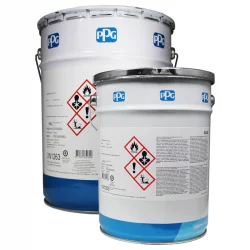
PPG SigmaGlide 890
2-component, silicone-based finish for fouling release systems on ships, installations and seawater intakes under all fouling conditions, for new-building or maintenance.Non-toxic. Can be used at temperatures above 5°C (41°F). No induction time. Can be applied by spray. Can be overcoated after 2 hours.For Reference:See our...
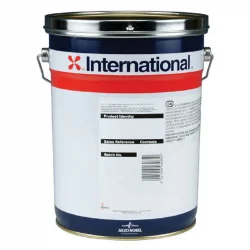
International Intersmooth 7460HS SPC
High solids, high performance, TBT free, low friction, self polishing copolymer (SPC) antifouling. Particularly suitable for use where solvent emissions need to be reduced.Specifically designed for deep sea vessels. For use at maintenance & repair. Dries (and can be overcoated) down to -5°C. Compliant with the International...
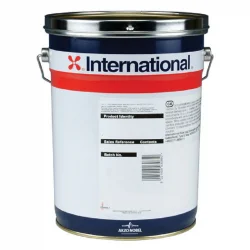
International Intersmooth 360 SPC
Black, brown, and dark-red high performance, TBT free, self polishing copolymer (SPC) antifouling system with patented copper acrylate technology.Specifically designed for coastal vessels. For use at maintenance & repair. Controlled polishing rate and continuous biocide release. Self-smoothing in service. Up to 36 months in-service...
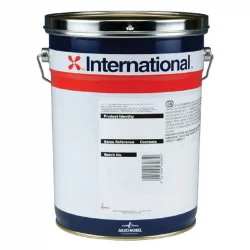
International Intersmooth 7465HS SPC
High performance, TBT free, low friction, self polishing copolymer (SPC) antifouling in brown. Particularly suitable for use where solvent emissions need to be reduced.Specifically designed for deep sea vessels. For use at newbuilding. Compliant with the International Convention on the Control of Harmful Anti-fouling Systems on Ships,...
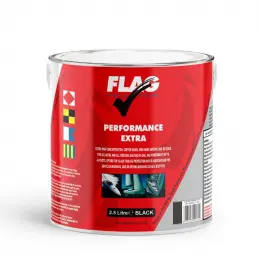
Flag Performance Extra Cruising Antifouling
5 colours. Copper based antifouling which is semi-hard to enable use in most craft up to 40 knots, but it is still able to refresh its surface with some mild erosion. It is suitable for long distance cruisers, racing sail and powerboats due to the semi-hard nature of the paint system.For use on boat hulls for all areas - Proven performance...

PPG Sigma EcoFleet 290S
Flat red brown antifouling coating. Linear polishing particularly suitable for deep sea-going vessels. Complies with IMO Antifouling Systems Convention.For Reference:See our guide to applying anti-fouling paints in-line with the "Protect Collect & Dispose Initiative".

PPG Sigma EcoFleet 690
Flat red brown high-activity, self-polishing antifouling coating. For extreme and aggressive fouling conditions. TBT-free self-polishing antifouling for maintenance and repair market. Specifically designed for coastal and low activity vessels. Complies with IMO Antifouling Systems Convention.For Reference:See our guide to...

CLEARANCE - Teamac Antifouling D Plus - Black 5L
Limited sizes, finishes and colours available. See options below for available quantities. Teamac Antifouling D Plus discourages the growth of barnacles, weed, and other water life on the underwater areas of marine vessels. Contains a high level of cuprous oxide and a blend of biocides to give good antifouling performance.Designed for...

Jotun NonStop II
Antifouling paint providing marine fouling protection. In black, dark blue, red and white. For yachts, vessels and aluminium hulls - up to 12 months of protection. Accredited with IMO Antifouling System compliance, ensuring adherence to marine safety standards.

Jotun Aqualine Spray
Grey antifouling spray for protection of drives, propellers, and underwater metal parts. For metal components below the waterline. Self-polishing properties ensure a controlled release of biocides for long-lasting effectiveness. Offers protection for up to 12 months.

Jotun Megayacht Imperial
Black hydrolysing antifouling coating designed for superior fouling protection. For immersed aluminium, carbon steel, composite, and wood substrates. Self-polishing characteristics reduce hull deterioration and friction.

Jotun SeaQuantum Classic S
Dark red silyl acrylate antifouling coating. Ideal for marine underwater hulls, new builds, and application during drydocking operations. Stable, self-polishing characteristics for reduced hull friction. Professional use only.
Need Help?
Need Help?
The Need for Anti-Fouling Paint in the UK
Water Areas Prone to Fouling
The UK’s diverse marine environments, including rivers, streams, seas, and coastal areas, are particularly prone to marine fouling due to their rich biodiversity. Areas such as:
- The Thames River: Known for heavy traffic and nutrient-rich waters that promote rapid marine growth.
- The English Channel: High salinity and busy maritime routes increase the likelihood of fouling.
- Scottish Lochs: Freshwater bodies that can still experience significant fouling, particularly from algae.
- Bristol Channel: Muddy waters with high organic content that foster fouling organisms.
Industries and Commercial Use of Anti-Fouling Paints
The maritime industry is a cornerstone of the UK economy, encompassing a wide range of activities from commercial shipping and fishing to offshore energy production and recreational boating. Each of these sectors relies on the effectiveness of anti-fouling paints to maintain operational efficiency and protect their investments in marine vessels and infrastructure.
Key Industries Utilising Anti-Fouling Paints
Commercial Shipping
Commercial shipping is critical for the UK, given its status as an island nation heavily dependent on maritime trade. Cargo ships, tankers, and container vessels traverse busy sea routes like the English Channel and North Sea, which are notorious for their high fouling rates due to the warm, nutrient-rich waters.
Types of Vessels: Tankers, container ships, bulk carriers, and ferries.
Importance of Anti-Fouling: Ensures these vessels maintain their speed and fuel efficiency, reducing operational costs and transit times. Anti-fouling paints like Jotun SeaQuantum Ultra offer long-term protection, essential for vessels with extended periods between dry dockings.
Fishing Industry
The fishing industry operates extensively along the UK’s coastline, from the North Sea to the Celtic Sea. Fishing boats, trawlers, and other vessels frequently encounter fouling organisms that can impair their performance and hygiene.
Types of Vessels: Fishing trawlers, crabbers, lobster boats, and smaller fishing vessels.
Importance of Anti-Fouling: Protects against biofouling that can reduce catch efficiency and contaminate fish holds. Products like Teamac Antifouling D are popular for their effectiveness in such environments.
Offshore Oil and Gas
The offshore oil and gas industry in the North Sea requires reliable anti-fouling solutions for both vessels and fixed structures like rigs and platforms.
Types of Vessels: Supply vessels, oil tankers, and maintenance ships.
Fixed Structures: Oil rigs, production platforms, and underwater pipelines.
Importance of Anti-Fouling: Ensures the longevity and efficiency of supply vessels and prevents fouling on underwater structures, which can lead to increased drag and corrosion. PPG Sigma EcoFleet 690 is specifically designed for coastal and low activity vessels in extreme and aggressive fouling conditions.
Recreational Boating and Yachting
The UK boasts a vibrant recreational boating and yachting community, with numerous marinas and yacht clubs dotting the coastline from the Solent to the Firth of Clyde.
Types of Vessels: Sailing yachts, motorboats, dinghies, and personal watercraft.
Importance of Anti-Fouling: Maintains vessel performance and aesthetics, crucial for competitive sailing and personal enjoyment. Consumer use products like Jotun Mare Nostrum SP or Teamac Protector II Antifouling are favoured for their ease of application.
Types of Vessels and Anti-Fouling Technologies
Old vs. New Technologies
Traditional Vessels
Wooden Boats: Historically, wooden hulls were prone to severe fouling. Early methods included copper sheathing and toxic lead-based paints.
Steel Hulls: More durable but still required regular anti-fouling maintenance to prevent rust and fouling.
Modern Vessels
Fibreglass and Composite Hulls: Modern materials that are lighter and more efficient but still require anti-fouling coatings to maintain their performance.
Advanced Technologies: The development of biocide-free paints and nanotechnology coatings reflects the industry's shift towards environmentally friendly solutions. For instance, nanotechnology-based anti-fouling paints offer non-toxic, durable protection that disrupts the attachment of fouling organisms.
Static, Underwater, and Offshore Infrastructure
Anti-fouling paints are not limited to vessels. They are also critical for static, underwater, and offshore infrastructure. Structures such as piers, oil rigs, and underwater pipework face similar challenges with marine growth, which can lead to significant operational and maintenance issues.
Key Infrastructure Using Anti-Fouling Paints
Piers and Harbors
Piers and harbour structures are constantly submerged or in contact with seawater, making them prone to fouling.
- Challenges: Marine organisms can weaken the structural integrity of pilings and increase maintenance costs.
- Solutions: Anti-fouling paints are applied to submerged parts of these structures to prevent biofouling, extending their lifespan and reducing maintenance needs.
Oil Rigs and Offshore Platforms
Oil rigs and offshore platforms in the North Sea and other regions are exposed to harsh marine environments.
- Challenges: Fouling can increase drag on submerged structures, lead to corrosion, and hinder inspections and maintenance activities.
- Solutions: High-performance anti-fouling coatings, like Jotun SeaQuantum Ultra, are used to protect these structures. These paints offer long-lasting protection, crucial for minimising downtime and ensuring continuous operation.
Underwater Pipelines
Underwater pipelines, used for transporting oil, gas, and other materials, are vulnerable to fouling and corrosion.
- Challenges: Marine growth can increase drag and pressure on pipelines, potentially leading to damage and increased operational costs.
- Solutions: Anti-fouling paints help keep pipelines clean and free from growth, ensuring efficient flow and reducing the risk of damage.
Aquaculture Installations
Aquaculture facilities, including fish farms and shellfish cultivation areas, require clean and safe underwater environments.
- Challenges: Biofouling can affect the health of farmed species and reduce water quality.
- Solutions: Anti-fouling coatings are applied to net fixings, cages, and other submerged equipment to maintain optimal conditions for aquaculture operations.
Application and Maintenance in Commercial Use
Seasonal Considerations
Spring: Ideal time for applying anti-fouling paints as vessels prepare for increased summer activity. This timing ensures optimal performance during the high-fouling months.
Winter: For vessels that are less active or docked, it is a good time to inspect and reapply anti-fouling coatings to prepare for the next season.
Environmental and Regulatory Considerations
The UK adheres to stringent environmental regulations regarding anti-fouling paints, particularly those containing harmful biocides. The International Maritime Organization (IMO) also sets global standards that impact local practices.
The British Coatings Federation (BCF), in collaboration with The Green Blue (a joint environment programme by the Royal Yachting Association and British Marine) and The Yacht Harbour Association (TYHA), has launched the ‘Protect Collect & Dispose’ initiative.
Biocide Regulations: Anti-fouling paints must comply with regulations limiting the use of harmful biocides like TBT (tributyltin).
Eco-Friendly Options: Increasing availability of environmentally friendly paints, such as those offered by International and Jotun, that minimise ecological impact while providing effective protection.
Scientific Data and Innovations
Impact of Biofouling
Fuel Efficiency: Studies show that heavy fouling can increase fuel consumption by up to 40% due to increased drag.
Maintenance Costs: Regular maintenance and anti-fouling treatments significantly reduce long-term costs associated with hull cleaning and repairs.
Advances in Anti-Fouling Technology
Nanotechnology: Provides a surface that resists biofouling without the need for toxic biocides.
Silicone-Based Coatings: Create a slippery surface that prevents organisms from attaching.
Self-Polishing Copolymers (SPC): Continuously renew the active surface, offering sustained protection and reducing the frequency of repainting.
What is Anti-Fouling Paint?
Anti-fouling paint is a specialised coating applied to boat hulls to prevent marine growth. There are different types of anti-fouling paints, each with specific properties and suited for various applications.
Types of Anti-Fouling Paint
- Hard (Scrubbable) Anti-Fouling Paint: Durable and can be scrubbed to remove growth. Suitable for high-speed vessels.
- Self-Polishing Copolymer (SPC) Paint: Dissolves at a controlled rate, providing continuous protection. Ideal for vessels that are frequently used.
- Hybrid Paints: Combine features of hard and self-polishing paints, offering a balance between durability and continuous protection.
Detailed Product Insights
Jotun Anti-Fouling Paints
- Jotun Mare Nostrum SP: Ideal for seawater, offering seasonal protection for a variety of boats.
- Jotun SeaForce Range: Includes SeaForce 30, 60, and 90, providing incremental protection from 36 months onwards.
- Jotun SeaQuantum Ultra: Best for prolonged protection, especially for offshore structures.
Teamac Anti-Fouling Paints
- Teamac Antifouling D: Suitable for steel, wood, and GRP, ideal for boats up to 30 knots.
- Teamac Antifouling A: Designed for aluminium hulls, requiring two coats for maximum effectiveness.
- Teamac Protector II: Designed for DIY application for when hobbyists wish to apply themselves
PPG Anti-Fouling Paints
- PPG Sigma EcoFleet 290S: Single pack, linear polishing ideally suited for deep sea going ships
- PPG Sigma EcoFleet 530: Single pack, self-polishing for high activity vessels providing up to 60 months service
- PPG Sigma EcoFleet 690: Single pack, self-polishing best for aggressive fouling coastal and low activity vessels
Flag Anti-Fouling Paints
Offer a small range ideal for the non-professional user wanting to carry out works themselves. Suitable for a variety of hull surfaces up to 40 knots in all water types.
International Anti-Fouling Coatings
Known for high-performance marine paints, International provides advanced anti-fouling solutions ensuring optimal hull protection and performance.
- International Intersmooth 360 SPC: 36 month service period with controlled self polishing and continous biocide release
- International Intersmooth 7460HS SPC: Compliant with the International Convention on the Control of Harmful Anti-fouling Systems on Ships. Particularly suitable for use where solvent emissions need to be reduced.
- International Intersmooth 7465HS SPC: High Performance, low friction brown antifouling for application during new build phase
Application and Maintenance of Anti-Fouling Paint
How to Apply Anti-Fouling Paint
- Preparation: Clean the hull thoroughly to remove any existing marine growth or old paint in accordance with the product data sheet of the antifouling paint or primer you’re about to use. Abrade the surface to create a suitable key for adhesion.
- Priming: Bare surfaces or hulls with an existing antifouling paint in good condition may require a suitable primer like Jotun Vinyguard Silvergrey 88 to act as a barrier and enhance adhesion.
- Painting: Use a brush, roller, or spray to apply the anti-fouling paint in accordance with the manufacturer's data sheet. Multiple coats will likely be required for optimal protection.
Maintenance
Regular inspection and cleaning are crucial. Check for any signs of wear or damage and reapply paint as necessary. Typically, anti-fouling paint should be reapplied every 12 to 24 months, depending on the type and usage conditions.
Anti-Fouling Paint FAQs
What causes the need for anti-fouling paint?
Marine environments, especially in the UK, are teeming with organisms that attach to submerged surfaces. These organisms, such as barnacles, algae, and mollusks, cause drag and increase fuel consumption. Regular use of anti-fouling paint helps prevent these issues by creating a surface that discourages attachment or makes it easier to remove these organisms.
How does anti-fouling paint protect marine vehicles?
Anti-fouling paint works by creating a barrier that either repels marine organisms or releases biocides that prevent their growth. This protection ensures that the hull remains smooth and free from growth that can reduce speed, increase fuel consumption, and cause structural damage over time.
What types of anti-fouling paints are available? The main types are:
- Hard Anti-Fouling Paint: Durable and ideal for high-speed vessels. It doesn’t wear away and can be scrubbed to remove fouling.
- Self-Polishing Copolymer (SPC) Paint: Wears away at a controlled rate, exposing a fresh layer of biocide. Suitable for vessels that remain in the water for extended periods.
- Hybrid Paints: Combine features of hard and self-polishing paints, offering both durability and continuous protection.
How to choose the right anti-fouling paint for my vessel?
Consider factors such as the type of vessel, what the hull is made from, its speed, and the water conditions it operates in. For instance, Jotun SeaForce is suitable for commercial vessels that need long-term protection, while Teamac Antifouling D is ideal for yachts and sailing boats operating at speeds up to 30 knots.
Can I apply anti-fouling paint myself?
Yes, with the right preparation, equipment, and product choice (a lot of antifouling paints are for professional use only so be sure to choose one that is for 'consumer use') boat owners can apply anti-fouling paint themselves. However, professional application ensures optimal coverage and performance, particularly for larger vessels or those in commercial use.
What are the environmental considerations of anti-fouling paints?
Many anti-fouling paints contain biocides that can impact marine ecosystems. It's important to choose environmentally friendly options and follow local regulations to minimise ecological harm. Brands like International offer eco-friendly paints that comply with strict environmental standards.
What are the best brands for anti-fouling paints in the UK?
Leading brands include:
- Jotun: Known for durable, high-performance paints like SeaQuantum Ultra.
- Teamac: Offers versatile options like Antifouling D and A.
- Flag: Provides cost effective solutions for various vessel types.
- International: Renowned for advanced, high-performance coatings.
How to maintain a hull with anti-fouling paint?
Regular inspections are essential. Check the hull for signs of wear or damage, and clean it regularly to remove any loose fouling. Touch up any damaged areas promptly to maintain continuous protection.
Are there specific recommendations for seasonal application?
Spring is the best time to apply anti-fouling paint as it prepares the vessel for the high-fouling summer months. Applying during dry, mild weather ensures proper curing and maximum effectiveness.
What are the differences between self-polishing and hard anti-fouling paints?
Self-polishing paints continuously expose fresh biocide layers, making them ideal for vessels that spend a lot of time in the water. Hard anti-fouling paints are more durable and scrubbable, suitable for high-speed vessels or those frequently hauled out.
Can anti-fouling paint be used on all types of boats?
Anti-fouling paint can be used on most boats, but compatibility with the hull material is crucial. For example, Teamac Antifouling A is specifically designed for aluminium hulls. Always check the manufacturer's recommendations for compatibility.
How do I know if my boat needs anti-fouling paint?
Signs include decreased speed, increased fuel consumption, and visible marine growth on the hull. Regular inspections will help determine if the paint needs reapplication.
What safety precautions should be taken when applying anti-fouling paint?
Wear protective clothing, gloves, and a mask to avoid inhaling fumes or coming into contact with the paint. Do not allow any uncured product to get into the watercourse. Ensure good ventilation if applying indoors, and follow all manufacturer safety instructions.
How does anti-fouling paint impact the resale value of a boat?
Well-maintained hulls with anti-fouling paint can enhance a boat’s resale value by demonstrating diligent upkeep and reducing potential buyers' future maintenance costs. Buyers appreciate vessels that have been regularly and properly maintained.
What innovations exist in anti-fouling technology?
Innovations include biocide-free paints, nanotechnology coatings, and eco-friendly options. For instance, nanotechnology-based anti-fouling paints provide non-toxic, durable protection by creating a surface that disrupts the attachment of fouling organisms.
How does anti-fouling paint interact with other hull coatings?
Compatibility is key when layering coatings. Using a sealer coat like Teamac Metaclor Antifouling Primer can ensure good adhesion between anti-fouling paint and existing coatings. Always consult manufacturer guidelines to prevent adverse reactions between different products.
What is the lifespan of anti-fouling paints like Jotun SeaQuantum Ultra?
Jotun SeaQuantum Ultra can provide protection for up to 90 months, making it ideal for long-term applications such as offshore constructions. Its longevity reduces the frequency of reapplication, saving time and costs over the vessel's lifecycle.
What should I do if my anti-fouling paint fails prematurely?
Inspect the hull for application errors, compatibility issues, or extreme fouling conditions. Correct any problems identified and reapply the paint as needed. Consult with professionals if unsure about the cause of failure.
What Rawlins’ Customers Say:
Don’t just take our Technical Support Teams’ words for it, here’s what our customers have to say about anti-fouling paint they have purchased from our store:
The information provided above is a basic overview and is intended as general information only. It is not advice, and is given without warranty. You should always refer to the relevant data sheets and our Technical Team prior to purchase or use of any products.
